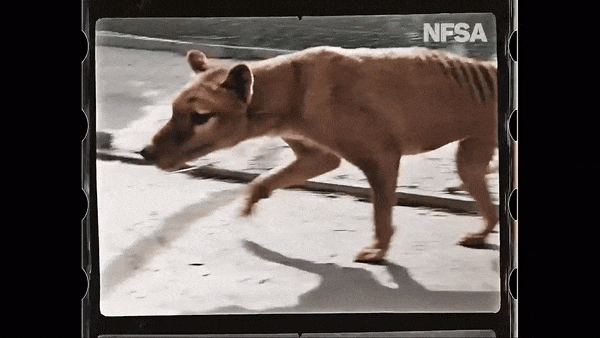Stunning colorized footage provides a glimpse of the last known Tasmanian tiger
Shot in 1933, the film shows Benjamin, the last thylacine in captivity in the world.
Nearly a century ago, a filmmaker captured a short black-and-white movie of the last known thylacine, also known as a Tasmanian tiger, as it padded around its enclosure at the Beaumaris Zoo in Hobart, Australia. Now, that long-dead animal, which his keepers named Benjamin, has "come back to life" in a new colorized version of the footage.
In the enhanced footage, which the National Film and Sound Archive (NFSA) of Australia shared on YouTube on Sept. 6, Benjamin has yellowish fur striped with dark brown over his back and rump. When he gapes his astonishingly long jaws in a head-stretching yawn, his tongue and the inside of his mouth are a delicate shade of pink.
Australian naturalist David Fleay captured the footage on 35-millimeter film in December 1933. The film and negative are in the NFSA's collection, and the negative was recently scanned at 4K resolution (horizontal resolution of at least 4,000 pixels) and then colorized under the supervision of film producer Samuel François-Steininger at Composite Films in Paris, NFSA representatives said in a statement.
Related: Australia's struggling marsupial: Photos of the Tasmanian devil
Colorizing the footage at such high resolution was challenging because the thylacine's fur was extremely dense, "and a lot of hair had to be detailed and animated," François-Steininger said in the NFSA statement.
Experts with Composite Films referenced preserved thylacine skins in museums to make sure that the film's new colors were accurate. They also read scientific descriptions of the animals and reviewed thylacine illustrations and paintings. Then, they turned to digital tools and artificial intelligence algorithms to seamlessly integrate color into each frame of the negative.
"More than 200 hours of work were needed to achieve this result," François-Steininger said.
Get the world’s most fascinating discoveries delivered straight to your inbox.
While thylacines (Thylacinus cynocephalus) are commonly known as Tasmanian tigers or Tasmanian wolves, they were neither wolves nor tigers. Rather, these extinct animals were once the biggest carnivorous marsupials in the world, with adults weighing as much as 66 pounds (30 kilograms) and measuring up to 77 inches (195 centimeters) long from their noses to the tips of their long tails.
Tasmanian tigers once roamed across Australia, but by about 2,000 years ago, they were found only on the island of Tasmania, where approximately 5,000 thylacines remained by the time Europeans colonized the continent in the late 18th century, according to the National Museum of Australia. By the mid-1930s, sightings of thylacines in the wild were exceedingly rare. After Benjamin's lonely death at the Hobart zoo in 1936, attempts to capture another thylacine were unsuccessful, and the species was declared officially extinct in 1986, the National Museum of Australia reported.
There are only 10 known film clips of living thylacines, and Fleay's footage is the longest, with a running time of about 80 seconds. But even a minute of filming may have been too much for Fleay's thylacine subject; shortly after the filmmaker captured the footage of Benjamin, the Tasmanian tiger bit Fleay on the buttocks, according to the NFSA.
Originally published on Live Science.

Mindy Weisberger is a science journalist and author of "Rise of the Zombie Bugs: The Surprising Science of Parasitic Mind-Control" (Hopkins Press). She formerly edited for Scholastic and was a channel editor and senior writer for Live Science. She has reported on general science, covering climate change, paleontology, biology and space. Mindy studied film at Columbia University; prior to LS, she produced, wrote and directed media for the American Museum of Natural History in NYC. Her videos about dinosaurs, astrophysics, biodiversity and evolution appear in museums and science centers worldwide, earning awards such as the CINE Golden Eagle and the Communicator Award of Excellence. Her writing has also appeared in Scientific American, The Washington Post, How It Works Magazine and CNN.




